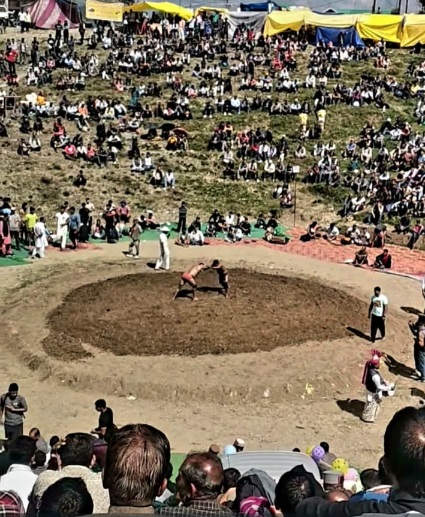Chhinj Mela: A Cultural Tour de Force of Pahadi Traditions
SHIMLA: In the quaint villages of Himachal Pradesh, the annual Chhinj or Kushti Mela holds a special place in the hearts of the locals.
Especially in places like Cheog and Fagu near Shimla, this traditional wrestling festival, celebrated as part of a larger village fair, is more than just a sporting event – it’s a cherished gathering of communities, a reflection of Pahadi culture that has stood the test of time.
For centuries, Chhinj has been synonymous with strength, endurance, and sportsmanship. Wrestlers, known as palawans, come from far-flung villages to compete in this age-old sport.
But beyond the competitive spirit, it’s the coming together of people – the villagers and spectators – that makes the mela a truly vibrant affair.
Families, friends, and even distant relatives reunite, bringing along local delicacies to exchange. This is a time when the hills come alive with chatter, laughter, and the sounds of traditional folk music.
These village fairs, once purely local and informal gatherings, are now being categorized by the government into various levels – from village, panchayat, and district fairs to those recognized on state, national, and even international stages.
Himachal boasts 21 melas with national status and seven with international recognition.
Some of the grandest melas, like the famous Lavi Fair in Rampur Bushahr, date back to a trade agreement between the kings of Rampur and Tibet, where woolen goods and animals were exchanged. Others, like the Kullu Dussehra and Mandi Shivratri, are revered for their religious significance.
But it’s the smaller village-level melas, like Chhinj, that truly capture the essence of Himachali culture.
These melas often coincide with seasonal celebrations, like Bishu and Jatar, where local deities, or devtas, are worshipped with devotion.
Thousands of these small fairs dot the state, each a microcosm of local traditions, rituals, and festivities.
One of the most striking features of these melas is the participation of women, who often step out of their homes for these special occasions.
Dressed in their finest traditional attire, their bright and colorful costumes add a beautiful vibrancy to the fairgrounds, making the event a visual spectacle.
While Chhinj melas remain a beloved tradition in places like Bilaspur, Solan, and Sundernagar, their charm is beginning to fade.
In an era of modern entertainment and changing lifestyles, these cultural tour de forces of Pahadi life are still alive, but not quite kicking with the same vigor as they once did.
Yet, the Chhinj mela, with its roots deep in the culture of the hills, continues to be a living symbol of the enduring spirit of the Pahadi people, reminding us of a simpler, yet deeply connected way of life.





